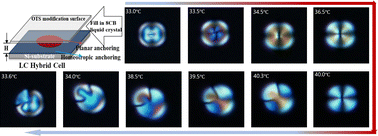The fate of liquid crystal topological defects on chemically patterned surfaces during phase transitions
Abstract
Controlling topological defects in liquid crystals (LCs) is an essential element in the development of areas such as directed self-assembly and micropatterning materials. However, during the phase transition on confined patterned surfaces, how the morphologies in one liquid crystalline phase change from deformations or defects into another phase is much less known. Here, we examine the fate of defects in a LC confined on a patterned surface during smectic-A–nematic and nematic–isotropic phase transitions, using experiments and simulation analyses. Upon heating from smectic-A to nematic, a Toric focal conical domain (TFCD) melts into a +1 converging boojum defect, which then transitioned into a concentric configuration as temperature increases, attributed to a steeper decrease of the bend and twist modulus compared to splay modulus. During cooling, TFCDs are developed from two distinct pathways depending on the cooling rates. Our continuum simulation recapitulates these transformations and provides elastic constant-based explanations for the two pathways. Although the phase transition pathways of defects are independent of the geometry of the confined patterns, the arrangement of FCDs is highly dependent on the size and shape of the patterns. Taken together, this simple approach offers promising opportunities for tuning the micro- or nano-patterning of topological defects in liquid crystals.



 Please wait while we load your content...
Please wait while we load your content...
